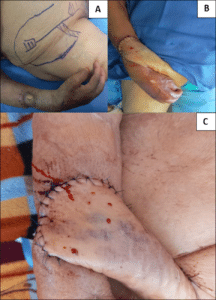Clinical Image | Vol. 3, Issue 3 | Journal of Clinical Medical Research | Open Access |
McGregor’s Flap: A Very Reliable Flap in the Hands of Novice Surgeons about a Case
Hatim Abid1*, Mohammed Bensaka1, Mohammed El Idrissi1, Abdelhalim El Ibrahimi1, Abdelmajid Elmrini1
1Department of Osteoarticular Surgery B4, Hassan II Teaching Hospital, Fes, Morocco
*Corresponding Author: Hatim Abid, Department of Osteoarticular Surgery B4, Hassan II Teaching Hospital, Fes, Morocco; Email: [email protected]
Citation: Abid H, et al. McGregor’s Flap: A Very Reliable Flap in the Hands of Novice Surgeons about a Case. Jour Clin Med Res. 2022;3(3):1-3.
Copyright© 2022 by Abid H, et al. All rights reserved. This is an open access article distributed under the terms of the Creative Commons Attribution License, which permits unrestricted use, distribution, and reproduction in any medium, provided the original author and source are credited.
| Received 11 Oct, 2022 | Accepted 27 Oct, 2022 | Published 04 Nov, 2022 |
Clinical Image
The inguinal flap is a remotely pedunculated “axial” flap. This is a very reliable flap for coverage of major upper limb soft tissue loss. It remains a flap of choice in the therapeutic arsenal of upper limb surgery, in emergency and deferred surgery [1-3].
McGregor in 1972 made the first description of this flap which depends on a constant vascular system [4].
The indication for this flap depends on the location of the area of soft tissue loss. It finds its place in the back of the hand and the forearm [5-7].
We report in this context the case of a 70-year-old female patient, who was referred to us from a provincial hospital for the management of cutaneous post-traumatic defect in the postero-external region of the right forearm.
For the cover, we opted, given its simplicity and reliability, for an inguinal flap with a completely favorable post-operative evolution (Fig. 1).

Figure 1: Intraoperative view of the skin defect. A: Wound debridement and landmarks tracing of surgical approach; B: The harvested flap; C: The flap appearance at 1 week of surgery with a satisfactory pin-prick test.
Conflict of Interest
All the authors declare that this work has been carried out respecting the recommendations of Helsinki.
References
- Guiga M, Fourati MK, Meherzi A, Belhassine H, Nahali N, Darghouth M. Notre expérience des lambeaux inguinaux pédiculés. A propos de quatre-vingts cas. Ann Chir Main. 1988;7(1):79-84.
- Wray RC, Wise DM, Young VL, Weeks PM. The groin flap in severe hand injuries. Ann Plast Surg. 1982;9(6):459-62.
- Baron JL, Benichou M, Louchahi N, Gomis R, Reynaud JP, Allieu Y. Technique et indication actually du lambeau inguinal en chirurgie de la main à propos de 100 cas. Ann Chir Plast Esthet. 1991;36(1):31-44.
- McGregor IA, Jackson IT. The groin flap. Br J Plast Surg. 1972;25(1):3-16.
- Gisquet H, Barbary S, Vialanex J, Dap F, Dautel G. The free groin flap utility: about 19 cases. Ann Chir Plast Esthet. 2011;56(2):99-106.
- Tintle LSM, Gwinn CSDE, Andersen LRC, Kumar CAR. Soft tissue coverage of combat wounds. J Surg Orthop Adv. 2010;19(1):29-34.
- Mathieu L, Gaillard Ch, Pellet N, Bertani A, Rigal S, Rongiéras F. Soft tissue coverage of war extremity injuries: the use of pedicle flap transfers in a combat support hospital. Int Orthop. 2014;38(10):2175-81.
This work is licensed under Attribution-NonCommercial-NoDerivs 2.0 Generic (CC BY-NC-ND 2.0) International License. With this license readers are free to share, copy and redistribute the material in any medium or format as long as the original source is properly cited.
Author Info
Hatim Abid1*, Mohammed Bensaka1, Mohammed El Idrissi1, Abdelhalim El Ibrahimi1, Abdelmajid Elmrini1
1Department of Osteoarticular Surgery B4, Hassan II Teaching Hospital, Fes, Morocco
*Corresponding Author: Hatim Abid, Department of Osteoarticular Surgery B4, Hassan II Teaching Hospital, Fes, Morocco; Email: [email protected]
Copyright
Copyright© 2022 by Abid H, et al. All rights reserved. This is an open access article distributed under the terms of the Creative Commons Attribution License, which permits unrestricted use, distribution, and reproduction in any medium, provided the original author and source are credited.
Citation
Citation: Abid H, et al. McGregor’s Flap: A Very Reliable Flap in the Hands of Novice Surgeons about a Case. Jour Clin Med Res. 2022;3(3):1-3.

